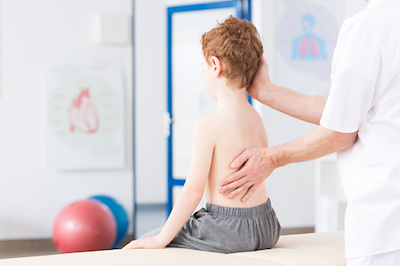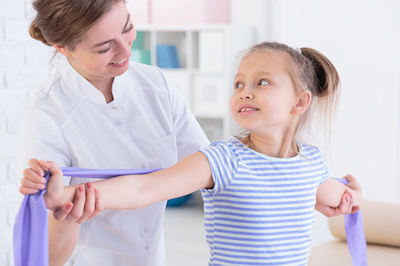What you should know if your child is double-jointed?
As an occupational therapist, I work with kids and their parents who have been told they have joint hypermobility, sometimes known as being “double jointed.” This might make it sound like the child has twice as many joints, but it simply means that a child’s joint is moving past the expected range. Joint hypermobility occurs when the soft tissues that surround and support each joint (also known as connective tissue) stretch more than usual and cause the joint to go beyond the normal range of motion. This can cause pain or discomfort and is often confused with or dismissed as general growing pains. Joint hypermobility is common in childhood, occurring in eight to 39 percent of school-aged children. Girls are generally more hypermobile than boys.
What can be done if my child is in pain?
It remains unclear why some hypermobile children experience pain while others do not. Education and therapeutic interventions can be targeted to this group before they start experiencing pain or sustain an injury or to help those who are already experiencing pain.
Children with one or more of the following symptoms may require an evaluation for joint hypermobility.
- Chronic joint pain
- Nighttime pain
- Loose skin
- Easy bruising
- Slow tissue healing
- Dislocated joint(s)
- Joint swelling
Should I take my child to see a pediatric specialist?
There are many specialists in addition to your primary doctor who can help diagnose, treat and provide education regarding hypermobility including orthopedics, rheumatology, genetics and sports medicine.
However, it is important to ensure that there is not another reason for your child’s musculoskeletal complaints. You should have your child evaluated by a specialist if their joint pain is accompanied by any of the following signs:
- Fever, malaise, weight loss, raised inflammatory markers, bone pain
- Persistent joint swelling
- Worsening night pain
- Abnormal growth (height and weight)
- Abnormal developmental milestones
- Delay (especially of major motor skills)
- Regression of achieved motor milestones
- Impaired functional ability (ask about play, sport, schoolwork, ‘clumsiness’)
- Limping (intermittent or persistent)
- Morning stiffness
- Widespread pain (such as upper limbs and back)
The role of the pediatric specialist is to evaluate for alternative diagnosis and they may assist in treating hypermobility by ensuring that their pain is controlled and monitor for injury that may occur due to joint hypermobility.
Treatment options for your child
Often times acetaminophen, ibuprofen or other anti-inflammatories are prescribed by your child’s physician. In addition to these pharmacological treatments, it is important that both you and your child understand how best to regain strength and prevent further joint damage.
 Children with hypermobility that affects their participation in daily activities should see a pediatric occupational therapist and/or a physical therapist. Therapists have special knowledge of joints and will provide advice on how to deal with joint misalignment or dislocation, protect the joints, how to use exercise to improve strength and provide education to prevent injury. Additionally, adaptive and supportive equipment may be recommended.
Children with hypermobility that affects their participation in daily activities should see a pediatric occupational therapist and/or a physical therapist. Therapists have special knowledge of joints and will provide advice on how to deal with joint misalignment or dislocation, protect the joints, how to use exercise to improve strength and provide education to prevent injury. Additionally, adaptive and supportive equipment may be recommended.
Often times a child with hypermobility may complain about fatigue with handwriting or have below age-level visual motor skills. Tightness in the shoulder muscles which restrict the ability for the hand to move across the page when writing and or drawing long lines may be the culprit in children with hypermobility. They may also adapt their pencil grip, which may restrict finger movements and then over compensate by using wrist movement leading to fatigue quickly with handwriting. An occupational therapist may assist in energy conservation, suggesting a new pencil grip and providing shoulder-strengthening exercises to decrease overall weariness with handwriting.
Due to frequent joint dislocations and/or sprains a child may suffer as a result of hypermobility, a child may need splinting, bracing, or a custom-made orthoses to prevent injury and protect joints. It is important that your child continue with their daily activities, as children with hypermobility tend to avoid being active due to pain, discomfort or the fear of pain with mildly strenuous physical activity. As a result, children can become deconditioned. Studies have shown that strengthening the muscles around a joint increased the stability of that joint and can prevent dislocation. Exercises can be provided for land or pool therapy to assist with strengthening. The role of the physical therapist is to educate the family and the child about hypermobility and joint protection, including proper body mechanics and positioning. In addition to education, the physical therapist will form a daily home exercise program that will slowly and progressively increase the load which will increase strength and coordination while decreasing discomfort. 
If your child suffers pain from hypermobility, be intentional about incorporating simple strategies that will get your child moving again. Find things that are fun and do not cause any pain. If your child likes the pool, a water regimen is a good place to start. Remember, it is important to help your child move past the fear of movement. After play be ready with a nice warm bath or hot packs, if they are needed. Engaging your child in an exercise that is challenging, builds strength, and requires effort will increase his or her self-confidence and willingness to keep going.
Where can I go for help?
As an occupational therapist, I am a part of the multi-disciplinary team within the Pediatric Rheumatology Specialty Practice. Our clinic here at Arnold Palmer Hospital for Children is in partnership with the University of Florida. Our team consists of a Pediatric Rheumatologist, physical therapist, occupational therapist, physician assistant, sports medicine fellow and a G.I. Nurse Practioner. We provide child-focused identification and treatment of auto-immune diseases. Should you suspect your child suffers from pain due to joint hypermobility or a rheumatic disease please contact your child’s primary doctor for a referral to visit our clinic.






